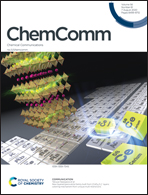Benzylic C–H heteroarylation of N-(benzyloxy)phthalimides with cyanopyridines enabled by photoredox 1,2-hydrogen atom transfer†
Abstract
A visible light initiated α-C(sp3)–H arylation of N-(benzyloxy)phthalimides with cyanopyridines for the construction of highly valuable pyridinyl-containing diarylmethanols, including bioactive motif-based analogues, is reported. This method enables arylation of the C(sp3)–H bonds adjacent to an oxygen atom through alkoxy radical formation by O–N bond cleavage, 1,2-hydrogen atom transfer (HAT), arylation and C–CN bond cleavage cascades, and offers a means to exploit 1,2-HAT modes to incorporate functional groups for constructing functionalized alcohols.



 Please wait while we load your content...
Please wait while we load your content...